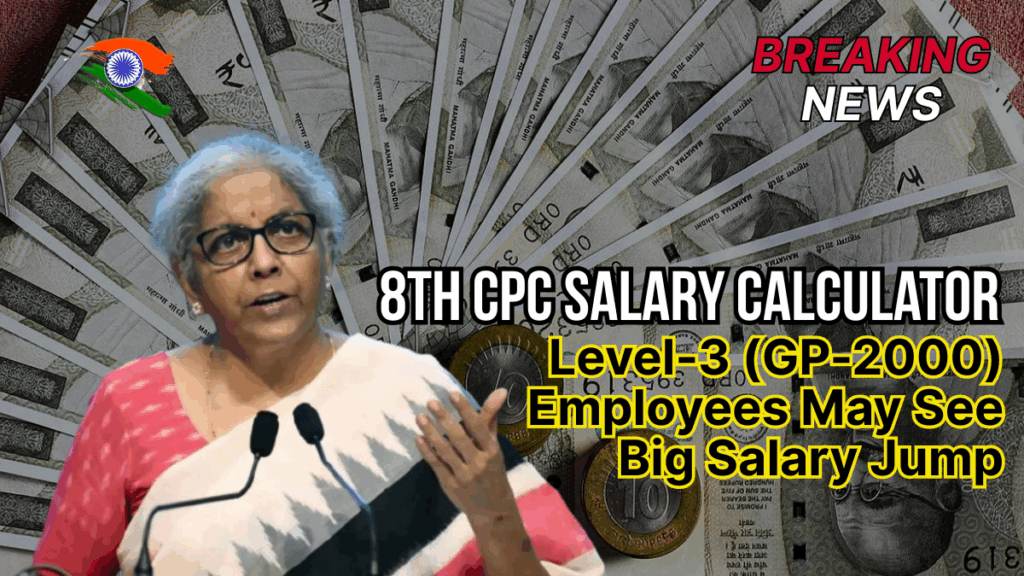Government employees across India are eagerly awaiting the implementation of the 8th Central Pay Commission (8th CPC), particularly those in Level-3 positions with Grade Pay ₹2000. While official recommendations are still pending, preliminary calculations suggest substantial salary increases that could significantly impact monthly take-home pay.

The anticipation stems from the potential for increased basic pay, revised allowances, and improved overall compensation packages. Understanding these projected changes helps government employees plan their finances and set realistic expectations for the upcoming pay revision.
Based on current projections using a fitment factor of 1.92, employees can expect meaningful salary improvements. However, the final figures will depend on the commission’s official recommendations and subsequent government approval.
Understanding the 8th CPC Fitment Factor
The fitment factor serves as the multiplier that determines how much basic pay increases under the new pay commission. For the 8th CPC, early estimates suggest a fitment factor of 1.92, though this could change based on final recommendations.
This factor directly impacts every aspect of salary calculation, from basic pay to allowances and deductions. A higher fitment factor means more substantial increases across all salary components.
For Level-3 employees currently earning a basic pay of ₹21,700, the revised basic pay would calculate as:
₹21,700 × 1.92 = ₹41,664
This represents a significant jump that forms the foundation for all other salary components.
Projected Salary Components Under 8th CPC
Basic Pay Revision
The most substantial change comes in basic pay, which nearly doubles under the projected fitment factor. Current Level-3 employees with ₹21,700 basic pay would see their salary increase to ₹41,664 monthly.
This revision affects all other allowances calculated as percentages of basic pay, creating a cascading effect of increases throughout the salary structure.
House Rent Allowance (HRA) Changes
HRA calculations depend on city categories, with X-category (metro) cities typically receiving 30% of basic pay. Under the 8th CPC projections:
- Current HRA: Calculated on ₹21,700 basic pay
- Projected HRA: ₹41,664 × 30% = ₹12,499
Some speculation suggests HRA percentages might adjust to 24% under the new commission, but even with this reduction, the absolute amount would likely exceed current allowances due to the higher basic pay.
Travel Allowance Updates
Travel Allowance for Level-3 through Level-8 employees in TPTA (Tier-I) cities is projected at ₹3,600 per month. This represents a standardized approach to travel compensation across similar pay levels.
The travel allowance typically remains fixed regardless of basic pay changes, providing consistent support for commuting expenses.
Complete Salary Breakdown: Level-3 Grade Pay ₹2000
Monthly Salary Components
Current Structure:
- Basic Pay: ₹21,700
- Various allowances based on current rates
- Standard deductions
Projected 8th CPC Structure:
- Revised Basic Pay: ₹41,664
- HRA (30% for X-category): ₹12,499
- Travel Allowance: ₹3,600
- Gross Salary: ₹57,763
Deductions Under 8th CPC
National Pension System (NPS): 10% of revised basic pay
- Deduction: ₹4,166 monthly
Central Government Health Scheme (CGHS): Fixed rates by level
- Deduction: ₹250 monthly for Levels 1-5
Net Take-Home: ₹53,347 (after deductions)
Why Dearness Allowance Resets to Zero
A common question among government employees concerns Dearness Allowance (DA) under the new pay commission. DA resets to zero because existing DA gets merged into the revised basic pay.
This merger prevents double-counting of inflation adjustments already factored into the new basic pay structure. Future DA increases will then apply to the revised basic pay, starting fresh from zero.
The reset ensures that employees don’t lose existing DA benefits while establishing a clean foundation for future cost-of-living adjustments.
Factors That Could Influence Final Figures
Government Fiscal Considerations
The final fitment factor depends on government fiscal capacity and economic conditions. A higher fitment factor means greater financial commitment from the government.
Economic factors like inflation, budget allocations, and overall fiscal health influence the commission’s recommendations.
Comparison with Previous Commissions
The 7th CPC used a fitment factor of 2.57, though circumstances differ for each commission. The 8th CPC’s recommendations will consider current economic realities and affordability.
Historical patterns suggest significant increases, but the exact magnitude depends on multiple economic and policy factors.
Planning for 8th CPC Implementation
Financial Planning Tips
Government employees should prepare for potential changes in take-home pay by:
- Reviewing current expenses and financial commitments
- Planning for increased tax obligations on higher salaries
- Considering investment opportunities with additional income
- Budgeting for potential delays in implementation
Timeline Expectations
Pay commission implementations typically take time for government approval and system updates. Employees should prepare for potential delays while maintaining realistic expectations about implementation timelines.
Arrears payments often accompany implementation, providing lump-sum benefits once the new pay structure takes effect.
Frequently Asked Questions
Q. Will all government employees benefit equally from 8th CPC?
A. Different pay levels and categories will see varying percentage increases. Lower-level employees often receive proportionally higher benefits, while senior positions may see different adjustment patterns.
Q. How will pension calculations change?
A. Pension calculations typically use the revised basic pay structure, potentially increasing future pension amounts for retiring employees.
Q. Are state government employees covered?
A. Central Pay Commission recommendations primarily apply to central government employees. State governments may adopt similar structures but implement them independently.
Preparing for the New Pay Structure
The 8th CPC represents a significant opportunity for government employees to improve their financial situation. While projections suggest substantial increases, the final figures depend on official recommendations and government approval.
Employees should use this time to understand the proposed changes, plan their finances accordingly, and prepare for the transition to the new pay structure. The projected increases could provide opportunities for better financial planning, increased savings, and improved quality of life.
Stay informed about official announcements and prepare for positive changes ahead. The 8th CPC could mark a transformative period for government employee compensation, making financial planning and preparation essential for maximizing these benefits.
For More Information Click Here
